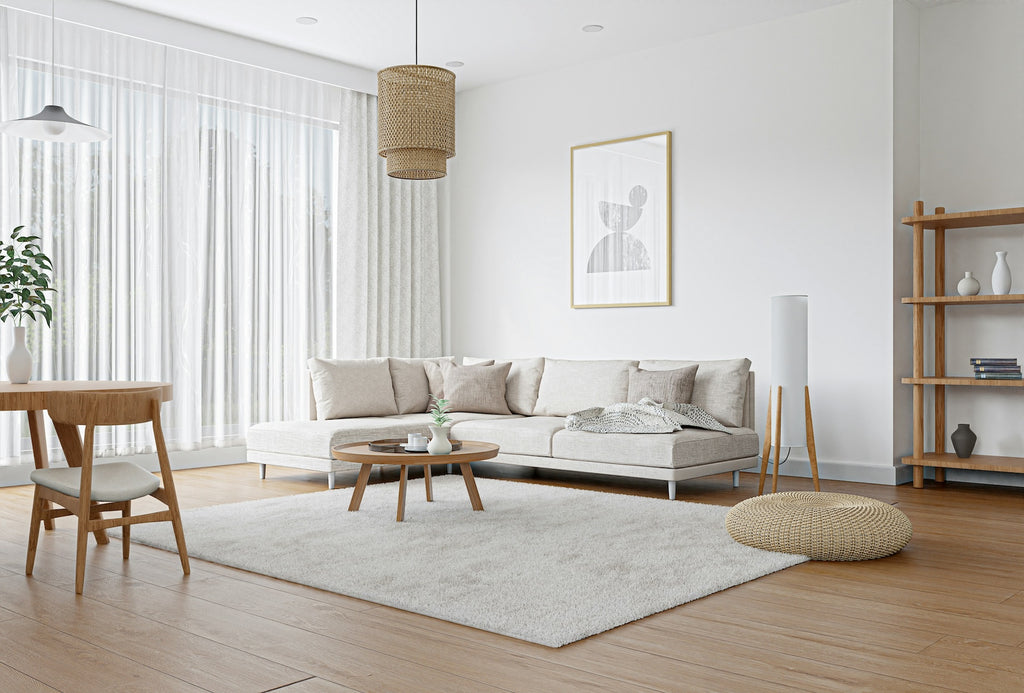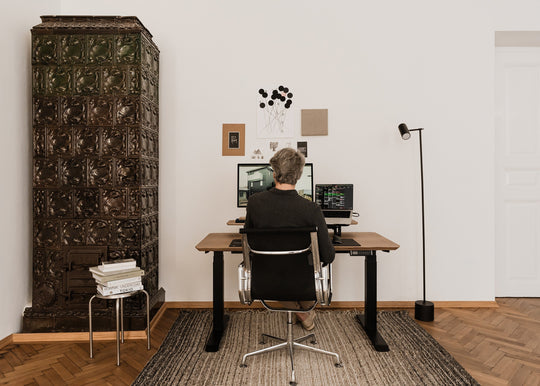
Creating a minimalist workspace with a classic desk
Natural materials, toned down, eye-friendly colors, functional but comfortable equipment, and a minimalistic aesthetics – an office space with this vibe invites productivity and work-life balance. What makes minimalism such a great home office design solution? And how to create Japandi inspired interiors with Oakywood’s Classic Desk?
Mid-century modern – 1960s minimalism
Minimalism is nothing new – this style of interior design has been with us for a good few decades. Simplicity and functionality are amongst the key concepts of Bauhaus,the famous German design school in the 1920s and 1930s. Even today, a 100 years later, its approach is described as distinctly modern. The Bauhaus aesthetic was a leading inspiration for American interior designers who, after World War II, created a brand-new style, later dubbed ‘mid-century modern’.

Embracing the simplicity and functionality
Geometric minimalistic forms native to Bauhaus have been further simplified with utility taking center stage. Streamlined shapes, straight lines, and lightweight patterns complimented design whose primary purpose was to provide its users with comfort. Still, practicality and pleasure went hand in hand with style – mid-century furniture possesses an undeniable and uncomplicated charm.
Wood or plywood?
Functionality, comfort, and aesthetics aside, mid-century interior design came without a hefty price-tag which contributed to its widespread popularity: everyone could afford to fill their home with fashionable furniture. Accessible prices meant some corners had to be cut at production level, meaning the items were made from plywood, plastic, or Plexiglas. Many designers at the time, however, used natural materials such as wood, leather, and stone.

Mid-century modern influence on Oakywood’s desks
Mid-century modern is a style we have decided to emulate – at least partly – designing our Classic Desks. The simple, lightweight form, softly rounded edges finished off with our unique chamfer, characteristically conical legs, and natural materials: solid wood or veneer, make the Oakywood desk look like a part of Mad Men set décor.
Japandi – when Japan and Scandinavia come together
Maybe some people think Japandi “just happened” but the relationship between Japan and Scandinavia already started a long time ago. After the closed-border policy of Japan for around 200 years they opened their borders in the mid 1850s. The Scandinavians who visited Japan were very enthusiastic about the country, culture and all the amazing items in the shops. These items became an inspiration for a lot of artists and designers in Scandinavia. Also, because of their shared love for craftsmanship it was “love at first sight”.
@japandi.interiorJapandi is a contemporary synonym for comfortable minimalism – the marriage of two iconic interior design styles: Japanese and Scandinavian. This is where we see modest form, natural materials, and a toned-down color palette. Functionality, comfort, and order take center stage – everything has its own place, and the interior is purposefully arranged to be a clutter-free, balanced space.

Photo by Eren Yildiz on Unsplash
Wabi-sabi and hygge
From its Japanese side, the movement inherited the wabi-sabi philosophy which puts emphasis on simple living alongside nature and appreciating the beauty in imperfections and items touched by the passage of time. Therefore, interiors designed in this style are full of natural, sometimes raw materials such as wood, stone, or linen. Laila Rietbergen shares that ‘in both Japan and Scandinavia, people love spending time amongst nature and they’re keen to bring some of that nature into their homes.’ The Scandi portion of Japandi is, on the other hand, saturated with the cozy hygge influences which adds comfort and softness to the space.
Benefits of Japandi: insights from interior designer
We asked Małgorzata Wojtyczka (@wojtyczka.pracowniaprojektowa), an interior architect, about the benefits of designing a minimalistic space. She said that the biggest advantages of Japandi are:
- a more organized life,
- more space to breathe, more freedom – a sense of control,
- less chaos and mess,
- more savings,
- thought out solutions,
- increased focus,
- boosted creativity,
- peace, harmony, and that Zen feeling.
In short, the Japanese and Scandinavian design fusion can help you achieve the desired balance – not only in your daily life but also in your professional career.

Why is minimalism so popular these days?
Lavishly embellished furniture and decorations overload in interior design are slowly becoming things of the past – more and more people choose simplicity and go with a minimalistic aesthetic. Are we getting exhausted by excess and disposable items which often bring about chaos? Or has the impending climate catastrophe forced us to appreciate the value of conscious consumption and sustainable development? Our design experts share their thoughts on the reasons behind minimalism’s success.
I think there are multiple reasons why this style popped up at this moment. One is the fact that the world, the way we look at it, and the way we treat it is changing. More and more people, companies, and governments are aware of their footprint. And you can even say that more people are “reconnecting” with nature. Japandi (life)style fits perfectly with this change. During the pandemic, a lot of people were spending more time at home. It became their workspace, daycare, and the place where you spend your leisure time as well. Because of this, and the reasons I mentioned before, I think a lot of people are looking for a style that is relaxing. The serene and calming aesthetics of Japandi and the craftsmanship of items that are more durable fits perfectly within these needs.
@japandi.interior
I think there are multiple reasons why this style popped up at this moment. One is the fact that the world, the way we look at it, and the way we treat it is changing. More and more people, companies, and governments are aware of their footprint. And you can even say that more people are “reconnecting” with nature. Japandi (life)style fits perfectly with this change. During the pandemic, a lot of people were spending more time at home. It became their workspace, daycare, and the place where you spend your leisure time as well. Because of this, and the reasons I mentioned before, I think a lot of people are looking for a style that is relaxing. The serene and calming aesthetics of Japandi and the craftsmanship of items that are more durable fits perfectly within these needs.
@wojtyczka.pracowniaprojektowaThe Classic Desk in a minimalist space
We designed our classic wooden desk for people who appreciate straightforward forms and like surrounding themselves with beautiful things. This is why it can be easily incorporated not only into the mid-century modern style but also other minimalistic movements such as Japandi. There are a few golden rules when it comes to setting your workspace in this style, and if you follow them, your home office will be transformed into an oasis of productivity, motivation, and healthy balance.

Tips for designing a Japandi-inspired workspace with our minimalistic desk
- Each element should be carefully thought through: think about whether an item is truly useful and won’t contribute to office clutter.
- Choose comfortable furniture, especially if you spend most of your workday in front of a computer: an ergonomic chair or chair alternative and, of course, a well-fitted desk.
- Wood can be combined with a variety of other materials: an oak or walnut desk looks striking alongside stone and metal but also natural textiles to soften your space.
- Don’t forget about some greenery – let nature move into your workspace and you will be rewarded with fresher air and reduced stress.
The classic wooden desk will look best next to a white or beige wall. Lamellas or wooden accents on the wall make for excellent additions as well. Hang black shelves above the desk for some contrast, and choose a chair composed of natural materials such as wood or rattan for added coziness. To add some extra depth, find a minimalistic but unique lamp or an interesting painting. We should remember that when it comes to arranging an office space, less really is more.
@wojtyczka.pracowniaprojektowaA tranquil and organized home office
Japandi places significant emphasis on order: reducing the number of your possessions makes it easier to keep your workspace well organized. According to Laila Rietbergen, functionality is key. She recommends choosing quality accessories to streamline everyday work. ‘I personally love the Felt & Cork Desk Mat that protects my table from scratching and works perfectly with the mouse. Also love the Felt sleeve for my MacBook. If I’m working on a different spot than my “normal” work spot, I place my laptop on the sleeve to protect both my laptop and the surface underneath it. At my standard work spot, I love to use the laptop stand as well. And, of course, I love the OakyBlocks to organize my accessories’.
Arranging your home office in a Japandi spirit requires you to acknowledge your specific needs and shed all that distracts, overwhelms, and annoys you. Remember that a comfortable space where you feel at ease brings you one step closer to achieving that perfect balance.








